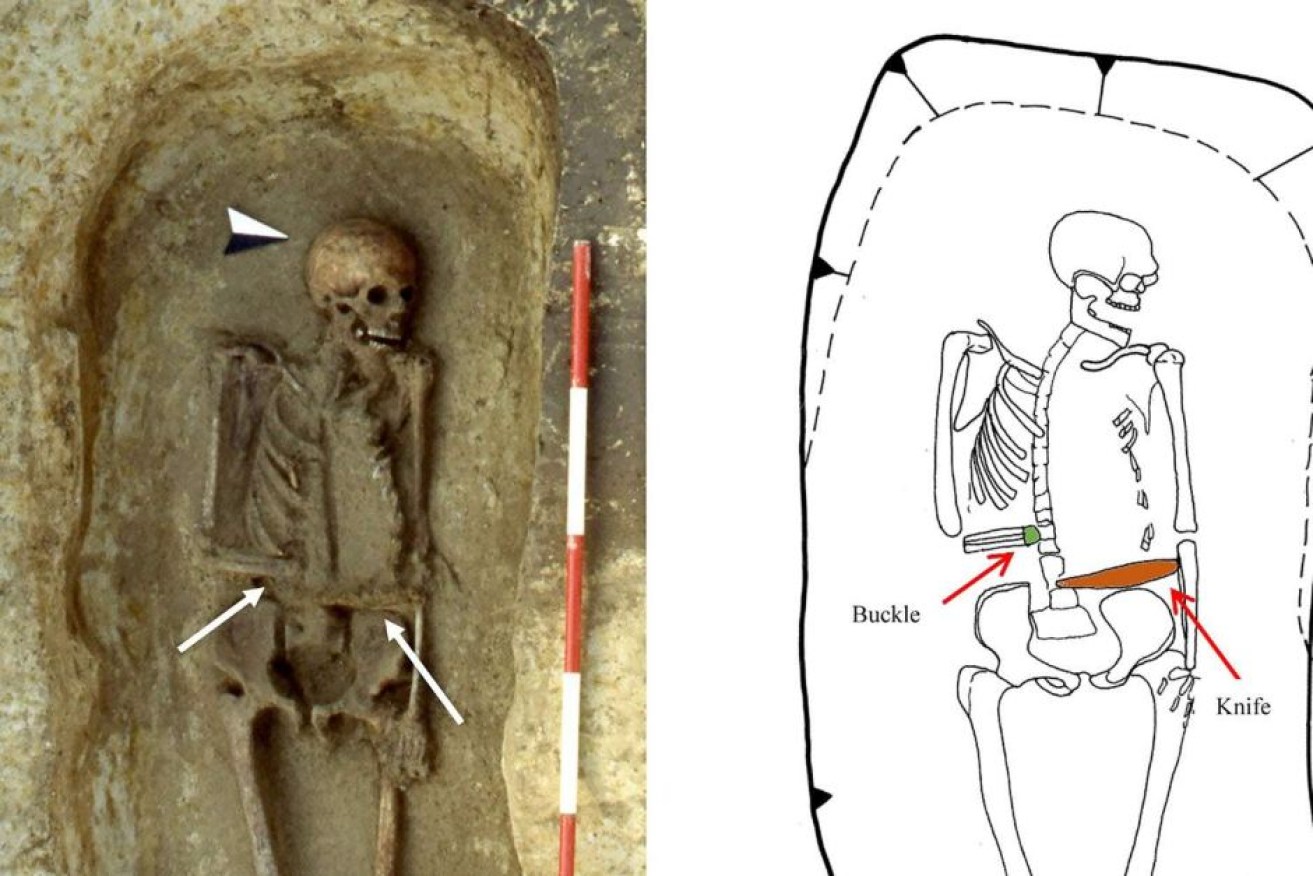Medieval skeleton with knife for a hand found in Italy

Photo and drawing of T US 380, showing the right arm, buckle and knife. Photo: Ileana Micarelli et al., 2018
Anthropologists working in northern Italy have revealed a cutting-edge medieval approach to surviving the sudden loss of a limb.
A male skeleton unearthed in 1996 and dating from some time in the 6th to 8th century AD showed evidence of a man who not only survived his right hand being chopped off, he attached a large knife in its place.
The remarkable specimen, known as T US 380, is described in new research published in the Journal of Anthropological Sciences.
T US 380 was recovered from one of 164 tombs excavated from the Longobard necropolis near Verona in northern Italy in the 1980s and 1990s.
An older male, he survived the cutting off of his hand by what was likely a single blow.
It actually healed quite nicely, researchers said, and he managed to live for quite a long time afterwards.
This was unusual in itself, given it happened during a time well before sterilisation techniques and antibiotics were widely used.
Also remarkable, though, was dental analysis which showed when he attached the knife to his right arm, he attached it — using a cap, leather straps and a buckle — with his teeth.

Photos of the skeleton’s teeth that show signs of wear, indicating the individual may have used their teeth to attach the knife. Photo: Ileana Micarelli et al., 2018
Hand could have been lost during combat
According to the researchers, the angle and position of the fracture on the forearm of the skeleton suggested that it was likely cut by a single blunt-force trauma to the arm.
One way this could have happened was during combat.
There is plenty of historical evidence, the researchers said, that males from this part of northern Italy were regularly involved in warfare activities, so the loss of the man’s forelimb during fighting was one possibility.
Another option was the amputation could have been due to a medical intervention after the man broke his arm somehow, resulting in an unhealable fracture or the formation of necrotic tissue or bone.
This could have resulted in a primitive surgery to remove the dead tissue and try to save the healthy part of the arm.
Otherwise, the man’s right forelimb could have been removed as a form of judicial punishment, a type of discipline which evidently did occasionally occur among Longobard people.
Whichever of these methods were responsible for the man losing his hand, he managed to survive it.
According to the researchers, the man was not only remarkable in his survival, he also adjusted very well to his condition by using a knife in place of his missing hand.
He also likely had considerable community support. Researchers said the man’s survival, without the use of antibiotics, was probably due to having a clean environment and intensive care from his community during the early stages of healing.
The community also had the ability to prevent death from blood loss, and used specific herbs for this purpose.
Callouses show prosthesis was probably used
Researchers said analysis of the bones on the skeleton indicated a “biomechanical force” — or a prosthesis — was placed on the stump.
The skeleton had round-shaped callouses on the ends of the bones, and a “bony bridge” that acted as a structural support between them.
The researchers said this could have been caused by the pressure of the bone against a prosthesis.
Researchers also suggested he damaged his shoulder joint by repeatedly using his teeth to attach his new “hand”.
From the archaeological evidence provided, researchers said the prosthesis the man used might have taken the form of a cap with a “modified bladed weapon” attached to it.
When they were excavating T US 380, archaeologists found a D-shaped buckle at the amputated site of the forearm, with rotted organic material surrounding it — most likely leather.
This suggested the cap and blade were attached with leather bindings, using the D-shaped buckle to hold them in place.
Man would have lived long after amputation
Despite sustaining an injury which would have essentially rendered him disabled, researchers said the radius and ulna bones in the arm were well healed.
This meant he would have lived for a considerable time after his forelimb loss.
According to researchers, the Longobard male represented an amazing story of how one man survived a forelimb amputation during an era before antibiotics.
“Not only did he adjust very well to his condition, he did so with the use of a culturally derived device, along with considerable community support,” they said.
“Most likely, he had a prosthesis that was used to protect the stump.”
As well as the unique knife prosthesis which still allowed him to use his right arm in some way, the survival and quality of life came down to, “community care, family compassion and a high value given to human life”.








